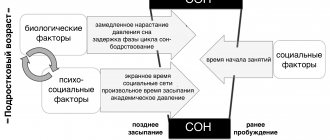“Schizotypal is diagnosed when there are not enough symptoms for pure schiza, but something happens to the person,” this is how ordinary people who are “in the know” characterize the disorder.
In scientific circles, schizotypal personality disorder is called a borderline state between schizophrenia and normality. The disease is accompanied by unusual behavior and pathological changes in thinking. The emotional sphere undergoes a special transformation.
Comparative characteristics
First of all, a parallel is drawn between SPD and schizophrenia. The symptoms of the diseases are really similar, so with the naked eye it is difficult to distinguish one from the other. However, obvious differences are still present.
Although schizotypal disorder has many features similar to schizophrenic disorder, its course is more favorable.
Symptoms in patients with schizophrenia are more intense. Hallucinations and delusions are persistent, obsessive, and force a person to break away from reality. A persistent personality defect is formed. The intellectual sphere suffers to a greater extent, manifesting itself in illogicality and absurdity of thinking. The disease leaves a negative imprint on a person’s consciousness.
Schizoid and schizotypal personality disorders are very similar. The diseases can be called related. The distinctive criterion is still the same intensity of expression, only now the “blanket over itself” is pulled by the SPD. The disease includes illusory, mild hallucinatory manifestations, and other psychotic symptoms. In schizoid disorder, changes affect more the emotional sphere.
A common thread running through both disorders is emotional shifts: alienation and emotional coldness. Sensory disturbances stand out sharply against the background of both conditions, which makes diagnosis difficult.
But if schizoid disorder manifests itself in childhood, then the schizotypal personality appears at an older age.
A young man, 21 years old, tells his medical history: “Just recently, everything was fine with me. He had a great respect for physics and took part in Olympiads. He became interested in microbiology and entered medical school. At the same time, I played the guitar and studied foreign languages (I speak three). Suddenly everything stopped abruptly. I didn't want to do anything. I abandoned my studies and then my hobbies. Soon he dropped out of life.”
Since schizotypal disorder is accompanied by obsessive actions, it is differentiated from obsessive-compulsive disorder. Hallucinatory manifestations make it possible to compare the disease with paranoid states.
The disorder is similar to autistic diseases due to its detachment from social contacts and stereotypical behavior.
Due to its wide range of symptoms, SPD has been associated with many diseases. Experts do not recommend using the diagnosis everywhere, since its recognition is difficult.
To make a diagnosis, the International Classification of Diseases has approved criteria, of which a person must have at least 4 over the past two years:
- emotional detachment;
- pretentious behavior;
- avoidance of social contacts;
- magical thinking;
- paranoid tendencies;
- obsessive thoughts without attempts to resist on sexual, aggressive topics, dysmorphophobic thoughts;
- derealization, depersonalization;
- psychotic episodes: illusions, hallucinations, delusions without external intervention;
- detailed, stereotypical thinking, intricate speech.
Where does the disease begin?
Schizotypal disorder arose from schizophrenia, subsequently emerging as a separate illness. Bleuler, in addition to the vivid schizophrenic symptoms identified by Kraepelin, drew attention to milder forms of the disease, from which its primary names come: latent, sluggish, non-psychotic, sanatorium schizophrenia.
There is a close connection between the inheritance of schizotypal disorder from close relatives with schizophrenia. In this case, the risk of acquiring the disease increases significantly.
About 3% of our planet's population is affected by the disease. It occurs more often in men than in women.
The disease begins with banal apathy:
- prostration;
- increased drowsiness;
- fast fatiguability;
- lack of motivation to action;
- brokenness;
- lethargy.
Such a bouquet inevitably harms performance. First, the individual loses the desire for self-realization and interest in professional activities. He does everything through force - it costs him unimaginable emotional and intellectual effort. Broken by stress, a person loses his job.
The schizotypal person is deprived of aspirations, desires, and gives up his favorite activities. Becomes lack of initiative. It is really difficult for the patient to carry out any actions, even the most minimal ones. From the outside, such behavior is perceived as laziness. People around them can be angry with a person, encourage him to act, try to convict a schizotypal person of weak will, and call him a weakling. But everything is to no avail: the patient simply cannot work.
Asthenic disorders are accompanied by senesthesia and senestopathy. Senesthesia refers to non-standard sensations in the motor sphere that are difficult to interpret. The sufferer is observed to have an unnatural gait: swaying from side to side, legs tangling. Hands hang like whips, head drooping.
Senestopathies are unpleasant, indescribable sensations in the body. The patient draws them artistically:
- feet burn with fire;
- the head is boiling like in a frying pan;
- It’s hard to breathe, as if your throat is being squeezed in a vice.
When unusual sensations appear, physical pathologies are excluded.
Apathetic disorders contribute to the development of gentle behavior. In order not to waste energy, the schizotypal person gets rid of unnecessary actions. Gradually he adapts to a limited life, albeit at a lower social and professional level.
Another category of patients, on the contrary, exhibits overcompensation, finds an absorbing hobby, and plays sports to the point of exhaustion. Still others resort to drugs and alcohol. Everyone is looking for their own way of adaptation.
When pathological changes grossly change personality, a person becomes maladapted in society. In this case, he loses the ability for minimal productive functioning, even to the point of disability.
Emotional poverty
Sensual stinginess is the main symptom of schizotypal disorder. The individual simply gradually loses all emotions. The process happens unnoticed by him. One day the sufferer realizes that he feels nothing. When asked by the doctor how you characterize your mood, there is only one answer - not at all.
And the process begins with anhedonia - the inability to receive pleasure. The sick person seems to lose his taste for life. What used to please and bring pleasure now does not matter. Small and great joys are equally indifferent.
The schizotypal person isolates himself from the outside world. Withdraws into himself. Attention is introverted, leading to self-digging and self-flagellation. The patient begins to find more and more shortcomings in himself, fixating on his own worthlessness. The character takes on the traits of shyness, pronounced modesty, and touchiness. It becomes difficult to maintain normal relationships with people and actively interact with society.
Rigidity increases and the speed of response to situations decreases. Plasticity gives way to stiffness. It is difficult for a person to adapt to changing circumstances and quickly switch from one activity to another. He seems to be stuck in one situation, marking time. What was once easy to do is now difficult. Schizotypals perform even automatic actions with increased self-control.
Emotional changes significantly transform personality. Patients themselves note changes in sensory responses that differ from those socially accepted. When crossing the road, a schizotypal person will not experience fear of a car rushing towards him. The conservation instinct will remain dormant.
Gradually, affective defects become noticeable to others. People may note that the patient has become unsociable and rarely rests in company. Loses emotional connection even with close people, although he willingly falls under the care of relatives. Thus, a girl with schizotypal disorder gladly accepted help in the form of household services from her elderly mother.
The personality of the sufferer acquires psychopathic traits:
- suspiciousness;
- hysteria;
- anxiety;
- conformity - submission to someone else's opinion.
Inappropriate behavior of a person in those situations in which he previously felt quite comfortable becomes indicative.
Emotional stinginess and anhedonic attitudes deny the patient the possibility of self-acceptance, so there is no question of empathy for others. The patient reacts to other people's feelings with silence, indifference, and rational stinginess.
There are signs of schizoidization:
- coldness in relations with relatives;
- lack of interest in social life;
- introversion, fixation on one’s inner world;
- lack of empathy;
- decreased social activity;
- loss of performance;
- reduced range of needs, satisfaction of primitive needs;
- increased vulnerability;
- rigidity – emotional, intellectual.
Psychotypical personalities are divided into two types.
- Neurosis-like appearance. In the center of the image are hysterical features with asthenia and obsessions. The symptoms are similar to the manifestations of neurosis, only there is no specific psychotraumatic situation. Schizotypy appears suddenly. A frustrating experience contributes to the event.
- Psycho-like appearance. Corresponds to the manifestation of the psychopathy of the same name. The desire for loneliness, callousness, severance of social ties, and unstable mood prevail in the clinic.
Causes
It is impossible to identify the exact reasons for the formation of a schizoid personality type; research is still ongoing. The following risk factors are expected:
- genetic, that is, congenital, characteristics of the individual;
- the presence of any mental spectrum disorders in close relatives - the theory of hereditary predisposition;
- environmental factors - social status, local mentality, characteristics of growing up;
- the nature of the relationship of parents or guardians to the child in the process of personality formation;
- the cumulation of experiences from early childhood to the present - stress, fear, loneliness, neglect from others, any type of violence.
It is not possible to talk about a single etiology, since the topic remains poorly studied even in a professional environment. Therefore, you should not specifically look for the most “convenient” reasons that explain the characteristics of a particular person.
Each clinical case should be reviewed by a psychiatrist, who will be able to determine the individual set of prerequisites that served as the impetus for the formation of SPD.
How does a schizotypal person think?
The thinking of schizotypal people is of particular interest. With intact intelligence and good memory, patients are forgetful. A person leaves the house, moves in a specific direction, but after a minute he completely forgets where he was going. He does not always manage to remember his destination. Periodically, the patient also cannot remember what he was doing a couple of minutes ago.
The thought process is too rational. It is predominantly schematic. Stereotyping is determined by limited concepts, dry, inflexible categories. Once created and fixed in the consciousness of the sufferer, an opinion about something cannot be changed.
Stereotypical thinking, in principle, provides invaluable help to humanity, saving time on understanding elementary, automatic actions - how to take a step, raise your hand. In schizotypal individuals, stereotyping goes beyond the norm, and no longer helps, but poisons existence.
What is associated with the mental block of a person with SPD? It's a matter of fixating the brain on unnecessary details. The intellectual organ gets stuck on secondary, insignificant things. Attention is directed in the wrong direction. Perception absorbs what is not useful for the main activity.
In some situations, this feature has its fruits. The ability to perceive small things, minor details, allows you to see more than an ordinary individual is able to absorb. Sometimes this “gift” flows into creativity.
Thinking has a philosophical orientation. The brain is attacked by mentalisms - involuntary influxes of thoughts that are particularly intrusive. They are full of crazy, sometimes perverted themes, giving rise to doubts and mistrust in the sick person.
A common type of mentalism is dysmorphophobia. An extremely valuable idea of the presence of a physical disability is born in the head. In fact, it may be absent. A complex of completeness often arises. Patients begin to be tortured by diets with illogical patterns, leading themselves to anorexia.
Dysmorphomania tends to progress, and florid obsessive thoughts and actions begin to appear. The latter flows into stereotypies. In addition, hypochondria with senestopathy is associated. A state approaches dysmorphic delirium is formed.
Sperrungs are another feature of the mental work of a schizotypal person. It manifests itself as a sudden interruption of thoughts - so-called slippages. There is a chain of thoughts in my head, and suddenly their sequence is lost. The man forgot what he was thinking about. We have to restore the events again.
Associative thinking operates on a sophisticated principle, as can be clearly seen from the association test. The patient combines objects according to a completely unthinkable principle.
Magical thinking is something worth mentioning. People with SPD tend to become fixated on superstitions and religious beliefs. One firmly believes: mention the devil and he will appear. Another is convinced that strangers are able to guide his thoughts. Thanks to the magic of thinking, the disorder was called occult schizophrenia.
There is even a special test for magical thinking - Magic Ideation Scale. MIS includes 30 questions, the answers to which are calculated by points. Then the total amount is displayed and the result is evaluated.
Schizotypal people have specific speech. Incoherent, difficult to understand. During a conversation, a person jumps from one topic to another without bringing the previous one to its logical conclusion. It is difficult to have a conversation with such people - you cannot grasp its essence.
The abrupt, illogical mental activity of a schizotypal personality causes significant trouble, exhausts, and causes rapid intellectual fatigue. Therefore, patients are not capable of long-term mental operations; they complain that they have difficulty even reading books or watching TV.
Obsessive-compulsive actions
Separately, it is necessary to note such symptoms of the disease as obsessive fears and actions. They so often accompany the illness that it is sometimes difficult to determine whether it is OCD or schizotypal disorder.
Among the frequently encountered fears are social phobia, agoraphobia, mysophobia, etc. One teenager with SR developed cancerophobia. His grandmother died of cancer. Moreover, at that moment, as he himself notes, he did not feel anything. Some time later, he watched a TV series in which they said that one of the first signs of brain cancer is phantom odors. From that moment on, he began to smell odors that were not really there. He was tormented by a terrible headache. And he was terrified that he had developed brain cancer.
An example of obsessive actions is the situation with a young guy. At school, his classmates made fun of him and bullied him in every possible way. Not knowing how to survive this, he simply repeated to himself the phrase: Lord, help. At first it was limited to 1-2 times. But then he needed to say it 10, 20 times to calm down and pull himself together.







